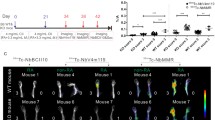Abstract
Purpose
To study the early change of bone matrix and soft tissue around articulation in adjuvant-induced arthritic (AIA) rats non-invasively by X-ray phase-contrast imaging (XPCI), a new imaging method.
Materials and methods
Adjuvant-induced arthritis was established in male Sprague–Dawley (SD) rats (n=6, age 40 days) by subcutaneous injection of Freund's complete adjuvant (FCA) into the left hindpaw. In vivo XPCI evaluation of the early soft tissue and bone changes in AIA rats was consecutively performed and correlated with changes in volumes of right hindpaws and body weights. In comparison, the changes in the AIA rats were also evaluated with absorption-contrast imaging using the same X-ray source as XPCI and conventional radiography at the same time. After the imaging evaluation, AIA rats were subjected to histological examination.
Results
There was significant difference between the score of XPCI and the other two methods in demonstrating soft tissue (P<0.01), bone details (P<0.01) and lesions (P<0.001). By day 10 after subcutaneous injection of FCA, bone changes in the right hindpaw were not obvious, but swelling of soft tissue appeared. By day 12, bone erosion in the articular facet and the area around the articular facet, was detected, along with osteoporosis, and swelling of soft tissue was aggravated. By day 14 bone erosions became fused and expanded, especially in the margin area around the articular facet. At day 16 bone erosion still existed. Joint interspaces seemed wider than normal, and swelling of soft tissue was significant. By day 18 periosteal new bone formation was seen definitely, destruction of bone decreased, bone density around the articular was enhanced, and swelling of soft tissue was relieved. XPCI could clearly distinguish all these alterations, which could not be demonstrated by absorption-contrast imaging and conventional radiography. During the test period, the volume of the right hindpaw and the body weight of the AIA rats also changed significantly compared with the normal rat. Histological examination confirmed that adjuvant-induced arthritis had occurred in all rats of the adjuvant group.
Conclusion
Osteoporosis, bone erosion and periosteal new bone formation take place at the early stage of adjuvant-induced arthritis. XPCI can evaluate non-invasively these subtle bone changes that are “blind areas” for conventional radiography.












Similar content being viewed by others
References
Koch AE. Angiogenesis: implications for rheumatoid arthritis. Arthritis Rheum 1998;41:951–62
Matsuno H, Yudoh K, Morita I. Apoptosis is a novel therapeutic strategy for RA: investigations using an experimental arthritis animal model. Mech Loading Bone Joints 1999;34:215–26
Kalden JR, Sieper J. Oral collagen in the treatment of rheumatoid arthritis. Arthritis Rheum 1998;41:191–4
Ostergaard M, Hansen M, Stoltenberg M, et al. New radiographic bone erosions in the wrists of patients with rheumatoid arthritis are detectable with magnetic resonance imaging a median of two years earlier. Arthritis Rheum 2003;48:2128–31
Gylys-Morin VM, Graham TB, Blebea JS, et al. Knee in early juvenile rheumatoid arthritis: MR imaging findings. Radiology 2001;220:696–706
Wilkins SW, Gureyev TE, Gao D, et al. Phase-contrast imaging using polychromatic hard X rays. Nature 1996;384:335–8
Menk RH. Interference imaging and its application to material and medical imaging. Nucl Phys B (Proc Suppl) 1999;78:604–9
Gureyev TE, Stevenson AW, Paganin D, et al. Quantitative methods in phase-contrast X-ray imaging. J Digit Imaging 2000;13:121–6
Baruchel J, Lodini A, Romanzetti S, et al. Phase-contrast imaging of thin biomaterials. Biomaterials 2001;22:1515–20
Takeda T, Momose A, Hirano K, et al. Human carcinoma: early experience with phase-contrast X-ray CT with synchrotron radiation—comparative specimen study with optical microscopy. Radiology 2000;214:298–301
Cloetens P, Pateyron-Salome M, Buffiere JY, et al. Observation of microstructure and damage in materials by phase sensitive radiography and tomography. J Appl Phys 1997;81:5878–86
Backhaus M, Burmester GR, Sandrock D, et al. Prospective two year follow up study comparing novel and conventional imaging procedures in patients with arthritic finger joints. Ann Rheum Dis 2002;61:895–904
Backhaus M, Kamradt T, Sandrock D, et al. Arthritis of the finger joints: a comprehensive approach comparing conventional radiography, scintigraphy, ultrasound, and contrast-enhanced magnetic resonance imaging. Arthritis Rheum 1999;42:1232–45
Jacobson PB, Borgan SJ, Wilcox DM, et al. A new spin on an old model: in vivo evaluation of disease progression by magnetic resonance imaging with respect to standard inflammatory parameters and histopathology in the adjuvant arthritic rat. Arthritis Rheum 1999;42:2060–73
Jones RS, Ward JR. Studies on adjuvant-induced polyarthritis in rats. II. Histogenesis of joint and visceral lesions. Arthritis Rheum 1963;6:23–35
König H, Sieper J, Wolf KJ. Rheumatoid arthritis: evaluation of hypervascular and fibrous pannus with dynamic MR imaging enhanced with Gd-DTPA. Radiology 1990;176:473–7
Østergaard M, Lorenzen I, Henriksen O. Dynamic gadolinium-enhanced MR imaging in active and inactive immunoinflammatory gonarthritis. Acta Radiol 1994;35:275–81
Yamato M, Tamai K, Yamaguchi T, Ohno W. MRI of the knee in rheumatoid arthritis: Gd-DTPA perfusion dynamics. J Comput Assist Tomogr 1993;17:781–5
Author information
Authors and Affiliations
Corresponding author
Rights and permissions
About this article
Cite this article
Yu, Y., Xiong, Z., Lv, Y. et al. In vivo evaluation of early disease progression by X-ray phase-contrast imaging in the adjuvant-induced arthritic rat. Skeletal Radiol 35, 156–164 (2006). https://doi.org/10.1007/s00256-005-0026-8
Received:
Revised:
Accepted:
Published:
Issue Date:
DOI: https://doi.org/10.1007/s00256-005-0026-8




